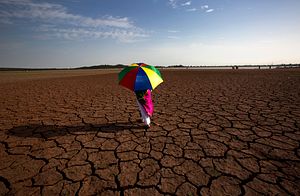The media is rife with stories of Pakistan’s financial crisis. Unwarranted and ill-founded parallels are being drawn with Sri Lanka. The fiscal situation in the country will soon stabilize (though not resolve) after the budget is presented on June 10 and the IMF releases a tranche of $900 million; this endorsement will prompt China, Saudi Arabia, and other countries to park some dollars as well. However, other problems will continue to haunt Pakistan’s socioeconomic and, as an extension, political circumstances.
The most pressing among these is the acute water crisis. This crisis will not only affect Pakistan’s agriculture sector, which contributes to 23 percent of Pakistan’s GDP and employs 42 percent of its labor force, but also it will take the form of an existential threat to energy and food security, and therefore national security.
A recent report, “Water Crisis in Pakistan: Manifestation, Causes and the Way Forward,” published by the Pakistan Institute of Development Economics (PIDE) sheds some light on the gravity of the issue by adducing eye-opening statistics. Pakistan ranks 14 out of 17 “extremely high water risk” countries in the world, as the country wastes one-third of water available. More than 80 percent of the country’s population faces “severe water scarcity.” Water availability in Pakistan has plummeted from 5,229 cubic meters per inhabitant in 1962 to just 1,187 in 2017.
One indicator highlighting the seriousness of the issue is the water withdrawal rate, which can be defined as the amount of water withdrawn from a source (surface or groundwater). Note that this is different from water consumption, which is the portion of withdrawn water that has been permanently lost as it was consumed (evaporated, used by plants or humans, etc.). Pakistan has been ranked 160th, better than only 18 countries, in terms of water withdrawals to water resource ratio. Moreover, the country treats only 1 percent of wastewater, one of the lowest rates in the world. Around 40 percent of water in Pakistan is lost due to spillage, seepage, side leakage, and bank cuttings along with irregular profiling of alignment of banks.
Agriculture is the largest consumer of water; 97 percent of Pakistan’s freshwater is used by the sector. The water crisis is putting the largest sector of the country’s economy at risk. Besides water deficiency and drought, there are other issues like water-logging and salinity affecting Pakistan’s crops, which are responsible for 60 percent of the agriculture sector’s contribution to GDP. An estimated shortage of around 70 million tons of food is expected by 2025.
Additionally, 30 percent of Pakistan’s land is expected to be waterlogged while 13 percent is saline. When coupled together with the overarching issue of growing water scarcity, one can see an existential threat to the country in the offing. Crop productivity is affected by water availability. This will impact cotton, which plays a pivotal role in the backbone of the country’s industry, textiles. Sugar is another crop that requires sufficient amounts of water and so does wheat.
Col. Abid, a senior defense analyst and an expert on water management in Pakistan, says that “climate change, the apathy of successive governments towards growing water shortage at all levels, and the lack of planning have resulted in a severe water crisis” in Pakistan. “The country has reached a stage where its water management system seems to be progressing in the wrong direction,” he argued, adding that “instead of getting better, the crisis is getting worse.”
Pakistan’s population is expected to exceed 380 million by 2050, according to a U.N. report. Moreover, by 2025 the demand for water in Pakistan is expected to reach 274 million acre feet (MAF) as compared to 191 MAF supply of water.
The problem is that policymakers, the media, and the public are least bothered with what I have described as a threat to Pakistan’s national security. Switch on the television and 99 percent of talk shows will be focused on politics — who said what to whom. This needs to change. It doesn’t require any computer model or algorithm or a verbose research paper to see that if the water crisis isn’t addressed with a proactive approach, this can even lead to conflict between provinces, which can tear away the fabric of social cohesion, further weakening Pakistan from within.
Water crisis and its management should be prioritized to the highest degree. Pakistan should impose a water emergency and engage at international and national level to solve its crisis before it gets too late.

































